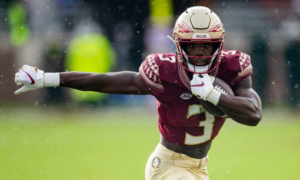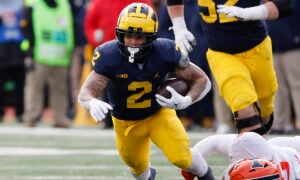Historically High Target Share Swings and How to Ride Them
How likely is it that Keenan Allen keeps his 27% target share from 2017? Is DeAndre Hopkins more or less likely to see a drop in volume after going over 30% in targets in 2017? Will Jarvis Landry see the kind of volume he had in Miami in Cleveland?
The answer to those questions are: I don’t know. But I can tell you about how players with enormous target shares have fared in the past. Hopefully this can provide some context for high volume players going into 2018.
In that context, the answers are: he probably will be close, he probably won’t by much, and maybe now.
Based on all wide receiver seasons from 2000 to 2016, players with high target volumes tend to keep those high target volumes. I’ll also show you something about the ones who didn’t.
I’m using data from ffstatistics.com for all of these tables and tools.
[am4show have=’g1;’ guest_error=’sub_message’ user_error=’sub_message’ ]
A who’s who of volume
Just so we know who we’re looking at from 2017, here are the top target shares last season:

Only seven players had more than 27% of their team’s targets last year. Only ten had more than 26% of targets and there is a steep drop off from there.
- While DeAndre Hopkins’ target share was insane last year, he’s also been over 30% twice in his career and hasn’t been below 25% in any season but his rookie campaign.
- A.J. Green has been over 20% in target share twice in his career, over 22% five/seven seasons, and has never had less than 21% of targets in any season he’s played more than 12 games (including his rookie year).
- In any season Julio Jones has played more than 13 games, he has had over 20% of Atlanta’s targets. In those seasons, he has averaged 26% of targets and in the last four years, he has averaged 27% of targets and been above 30% once.
- In any season Antonio Brown has played more than 13 games (six/eight seasons), he has averaged 27% of targets.
- Jarvis Landry. A bit of a cheat since I’m not mentioning the others who had 26% of targets last year – but we know he has been enjoying a monster work load and I think he’s someone we’re all interested in for 2018 in terms of volume. He hasn’t had less the 26% of targets in the last three years and even had 18% in his rookie season.
- Keenan Allen’s 2017 usage was far above his norm, however in every season he’s played 14 or more games, he has never been below a 19% target share.
- Adam Thielen saw a career-high in 2017. His second-best (the year before) was 15% of targets.
- Michael Thomas‘ 2017 target share was 10% more then he had in his rookie season.
Over the last ten years, the WR1 on an NFL team has averaged 22% of his team’s targets. That’s the loose goal a player needs to be the highest-scoring wide receiver on his team. You can explore this and other positional averages and by team, head coach and offensive coordinator using this tool I just built: https://docs.google.com/spreadsheets/d/1HFTbYqlC1OpBxMyMGQNZuVE-wleyqP9kGET_4KHpBjY/edit?usp=sharing

The History of Swinging
I went back and looked at all wide receiver seasons where the player held a 27% or greater target share between 2000 and 2016. I found 142 such seasons, and 109 of those players played 14 or more games the next year. Since we’re looking at all season and not just all players, this also means we are tracking each target hog through time as well.
What I found was that 55% of players with a 27% target share or more kept about the same level of high target share. Their targets didn’t change +/- more than 3% the following.
This is also clear when 67% of players retained at least a 25% or greater target share the year after their high target share season.
Only 1.8% of players saw a decrease in targets share greater than 5% and only ten (9%) saw a 10% or greater drop in target share.
In other words, those who have earned a high target share, have tended to keep an above-average share the next year. But we should also factor in a potential 3-5% drop in most instances

Players who changed teams
The single greatest risk factor in losing targets the next season was a team change.

The players who changed teams show a significant loss in targets about 50% of the time (9% or greater) but on the other hand, seven/ten players who lost more than 10% of their targets the following year at all, had changed teams. This means a target hog is a lot more likely to lose a significant % of your targets if you change teams than if you remain on them.
Keenan Allen, for instance, is more likely to retain 25-27% of the Chargers’ targets than Jarvis Landry is to keep a target share over 22%.
Remember that 27% of targets is a very high bar to reach and shouldn’t be expected of almost anyone. However, even those players who only go there once in their career managed to sustain an above 19% target share the following year if they stayed on the same team.

So, Adam Thielen and Michael Thomas – who’ve dominated targets like this only once before – shouldn’t be expected to see a drop below at least a top 12-15 type target share in 2018.
In conclusion
I still don’t know. But, what seems intuitive, is backed up by the history of wide receivers with large target shares. Jarvis Landry is at risk of losing more targets than he can use to sustain a WR1 performance. Michael Thomas and Keenan Allen are more likely to receive 25% of their team’s targets than they are to drop to a league average 22% for WR1s.
Adam Thielen could fall behind Stefon Diggs in targets in 2018. But if so, I’d imagine Diggs to have a very high target share himself. Even with only one year above 22%, Thielen looks more likely to retain a 22% or greater share than he is to fall below 19%.
While DeAndre Hopkins’ target volume is likely to regress in 2018, I’d be surprised if he went below 26%. While regression is real and inevitable, in general we should not fear it for wide receivers with high target shares. They tend to be players who have earned those targets and, as such, if healthy, retain above average roles for their teams.
The player I think this highlights to most is Adam Thielen, who has a very nice high floor even compared to his current ADP of 31 as WR17. It also bolsters the case, in my opinion, that Keenan Allen should be above Mike Evans in ADP.
[/am4show]
- Peter Howard: Dynasty Fantasy Football Superflex Rankings Explained - March 6, 2024
- Dynasty Target and Regression Trends: Week 15 - December 23, 2023
- Dynasty Target and Regression Trends: Week 14 - December 16, 2023


































































